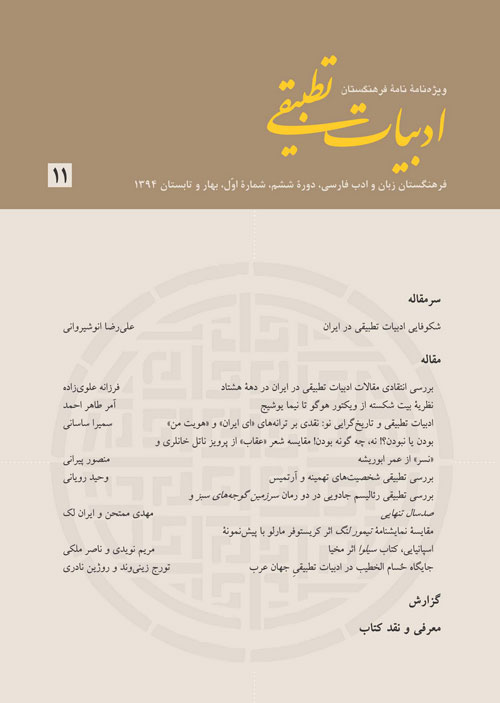فهرست مطالب

نامه فرهنگستان
سال چهاردهم شماره 2 (اسفند 1393)
- ویژه نامه دستور (10)
- تاریخ انتشار: 1393/12/19
- تعداد عناوین: 13
-
- مقاله
-
صفحات 65-78
-
صفحات 79-88
-
صفحات 147-162
-
صفحات 199-248
- نقد و بررسی
-
صفحات 249-260
-
صفحات 261-272
- یادبودها
-
صفحه 273
-
Pages 3-24The present study is an attempt to investigate the syntactic, information and lexical features of theme, topic and focus as three functional concepts, conducted based on Halliday’s Functional Theory and Chomsky’s Minimalist Program. The study sheds light on these concepts and their common and distinguishing points.First, topic and focus are defined and then a concise definition of theme is presented based on Halliday’s Functional Theory. Finally, based on the definitions provided in the study and distinguishing these concepts from each other, the main question of the study, i.e. the possibility of defining a Theme Phrase in Persian is considered within the framework of Minimalist Program.Keywords: Topic, Focus, Theme, Information Structure, Topic Phrase, Focus Phrase
-
Pages 25-46World languages encode the copulative and locative/ existential constructions differently. Typological studies introduced in Stassen (2009) have yielded two strategies: share and split. Hence two different language types have been proposed. The share strategy employs the same verbs and the split one uses different verbs to encode these sentences. Using natural data, the present study examines the two strategies in Modern Persian in order to determine its language type. The data analysis shows that Persian employs various forms of copulative verbs /budæn/ ‘to be’, and /hæst/ ‘exists’ as well as their cliticized forms. The locative sentences also use the copular verb /budæn/, and its cliticized form. Therefore, Persian could be categorized as a share type. Yet, in the existential sentences which are of the locative category, the two compound verbs /voud daštæn/ ‘to exist’ and /mowud budæn/ ‘to exist’ can be seen in addition to the copulative verbs. Thus, Persian has the split strategy too. Hence Persian could be categorized in both language types – in line with Stassen’s prediction that some languages may employ both strategies.Keywords: copulative construction, locative, existential construction, share strategy, split
-
Pages 47-64In this paper, I will study three new grammatical points in Shhnme and heroic texts with examples from other texts. These cases/ points consist of: 1. use of preposition before object frequently in sample verbs in this pattern: (preposition + object + transitive verb) or (transitive verbs + preposition + object) in verbs such as, ‘to find’, ‘to do’, ‘to know’, ‘to say’ etc. 2. Pronoun of (t) in subject position as singular second person agreement marker of some verbs. 3. Use of (u) ‘he/she’ for demonstrative adjective (n) ‘that’. Probably two cases from these points are continuation of syntactic particulars in Middle Iranian languages.Keywords: Historical Grammar, Shhnme, Clitic Pronoun (t), Demonstrative Adjective
-
Pages 117-146There are four types of clausal dependents in Persian language: Clausal dependents of nouns, adjectives, verbs and sentences. The first section of this paper deals with two different kinds of clausal dependents of nouns: clausal adjuncts and clausal complements of nouns. Then the internal structures, differences and similarities of these two kinds of clause are discussed based on dependency grammar.Keywords: Clausal Dependents, Clausal Dependents of Nouns, Clausal Adjuncts of Nouns, Clausal Complements of Nouns
-
Pages 147-162There is a relative particle-i attached to the head noun of Persian restrictive relative clauses. The relative head marker –i occupies the determiner position (under D’) and takes the CP as its complement. The head noun and its optional determiner are base generated in the Spec of complex DP.Relative head marker –i and the head noun must merge under syntactic adjacency. This article aims to provide data related to this element to show that the head noun of relative construction is attached to the relative head marker-i which is an unstressed clitic but not to the indefinite marker-i or attributive affix -i. Data show that the deletion of the relative clause is accompanied by the deletion of relative marker and the clause can be deleted by the presence of attributive affix while the extraposition will be impossible. However, when attributive affix and relative marker-i are used in combination with each other extraposition is possible. It was also indicated that indefinite marker-i and relative marker-i are just homophone and have a different distribution and syntactic behavior.Keywords: restrictive relative clause, nonrestrictive relative clause, free relative clause, head marker, indefinite marker
-
Pages 163-198Scrambling is regarded as a syntactic process that moves constituents from their unmarked positions in sentences without changing the analytic meaning of the sentence. In this study, we try to figure out the effects of some functional motivations such as grammatical weight, definiteness, animacy and information structure on Persian scrambling. Since scrambling is a feature of spoken language, a spoken corpus of 1900 sentences were gathered. The analysis of data from this corpus showed that all mentioned factors, except animacy, had effects on scrambling. It was shown that the more definite a constituent, the longer a constituent, and the newer it is more easily scrambled. The results of a statistical analytic model showed that among the three independent variables; the information structure had more predictive effect.Keywords: scrambling, grammatical weight, information structure, definiteness, animacy

